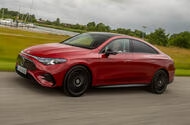How Does the New Mercedes-Benz CLA Achieve Such Impressive Range?
Let’s get right to the headline: 483 miles on a single charge. That’s not just a number—it’s a statement. The new Mercedes-Benz CLA isn’t just the longest-range EV you can buy in the UK right now; it’s also a showcase for what’s possible when efficiency takes center stage. Unlike the EQS or the Lucid Air Touring, which rely on massive, heavy battery packs to deliver their headline figures, the CLA takes a different path. It’s about squeezing every last mile out of a more reasonably sized 85kWh battery.
So, what’s the secret sauce? It comes down to a relentless focus on efficiency. The CLA boasts a WLTP rating of 5.0 miles per kilowatt-hour (mpkWh). For context, many rivals are still hovering in the low 3s. That’s a significant leap, and it means Mercedes has managed to deliver a car that goes further without simply adding more weight and cost.
Is Mercedes-Benz Reclaiming Its Place as a Technology Leader?
For years, Mercedes-Benz has been synonymous with luxury and engineering prowess. But in the electric era, some critics wondered if the brand was falling behind the likes of Tesla or newer upstarts. The CLA, however, signals a shift. By prioritizing efficiency over brute force, Mercedes is showing it can innovate in ways that matter to real drivers.
This isn’t just about numbers on a spec sheet. A lighter, more efficient car is more fun to drive, easier to live with, and—crucially—less resource-intensive to build. That’s a win for drivers and for the planet. Mercedes isn’t just keeping up; it’s setting a new benchmark for what a mainstream electric saloon can achieve.
How Does the CLA Compare to Other Electric Cars in Its Class?
Let’s talk value. The CLA starts at £45,615—right in the ballpark of a long-range Tesla Model 3. But where the Model 3 and other competitors often rely on larger batteries to hit their range targets, the CLA’s focus on efficiency means you get similar (or better) range without the extra weight or cost.
There’s also the question of charging. A smaller, more efficient battery charges faster, which means less time tethered to a charging station and more time on the road. That’s a real-world benefit that goes beyond the numbers.
What Does Greater Efficiency Mean for Everyday Drivers?
Here’s where things get interesting. Doing more with less isn’t just a clever engineering trick—it has real implications for your wallet and your daily routine. A lighter car is more agile and responsive. A smaller battery means lower production costs, which can translate to more competitive pricing. And, of course, using fewer rare materials is better for sustainability.
Imagine this: You’re planning a weekend getaway. With the CLA, you’re not just confident you’ll make it there and back on a single charge—you’re also spending less time waiting around for your car to juice up. That’s the kind of convenience that changes how people think about EVs.
Are There Any Trade-Offs to This Approach?
No car is perfect, and the quest for efficiency does come with its own set of challenges. Achieving a 5.0mpkWh rating requires meticulous attention to aerodynamics, weight, and powertrain optimization. Sometimes that means making tough choices about features or materials. But Mercedes seems to have struck a smart balance—delivering a car that feels premium without unnecessary excess.
It’s also worth noting that while the CLA’s range is impressive, real-world results will always vary based on driving style, weather, and terrain. Still, the efficiency gains are substantial enough that even in less-than-ideal conditions, drivers should see meaningful benefits.
What’s the Big Takeaway for EV Buyers?
The big takeaway? The new Mercedes-Benz CLA isn’t about perfection—it’s about smarter adjustments. Start with one change this week, and you’ll likely spot the difference by month’s end. Mercedes has shown that you don’t need a monster battery to go the distance. Instead, thoughtful engineering and a focus on efficiency can deliver a car that’s not just better for your wallet, but better for the world. That’s the kind of progress that feels worth getting excited about.

